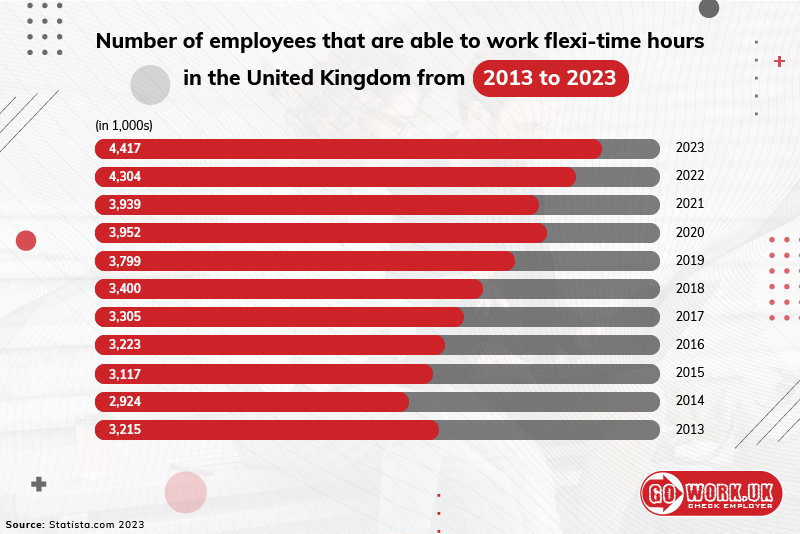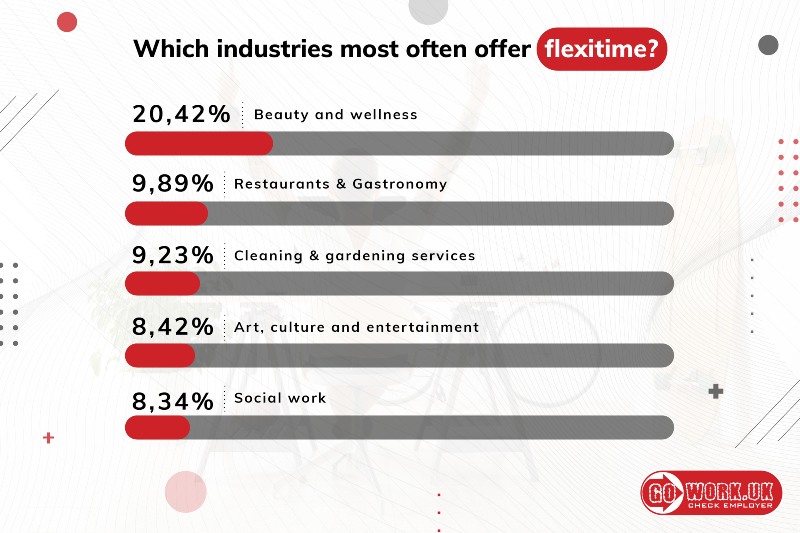A Decade of Flexibility: Shaping the UK Workforce – Gowork.uk Reveals the Most Flexible Industries

Flexible working has emerged as a powerful force reshaping the UK labour landscape over the last decade. With over a million more workers now offered the freedom to design their own schedules, it’s a movement that’s changing the way we view work. We checked which industries are leading the charge in providing flexible working hours, and which are struggling to keep up with this new work paradigm.
Table of Contents
How has the approach to offering flexible working hours changed over the last ten years?
Over the last decade, the approach to offering flexible working hours has undergone significant changes, driven by technological advancements, shifts in work culture, and evolving employee preferences. Technology allowed companies to better connect their talent across different regions and time zones.
According to Statista, the smartphone user base is estimated to reach 5.1 billion users and therefore a new peak in 2028 (2.6 billion in 2013). The users here are limited to Internet users of any age using a smartphone. This does not mean that everyone works using a smartphone, but it shows how many things can be done right away, how much people are used to using mobile devices and at least part of the work can be done at any time, thanks to the constant access to devices with the Internet.
The proliferation of digital communication tools, cloud computing, and collaboration platforms has made it easier for employees to work remotely and maintain communication with their teams. This has led to a broader acceptance of remote work and a more diverse range of flexible work arrangements. Although this is history today, the impact that the pandemic had on employers offering flexible working options, including hours, cannot be underestimated. The COVID-19 pandemic accelerated the acceptance of remote work. According to the WISERD Report it rose dramatically and suddenly in lockdown. The proportion reporting that they worked exclusively at home rose eight-fold from 5.7% of workers in the UK in January/February 2020 to 43.1% in April 2020. Many companies were forced to adopt remote work policies to ensure business continuity, which led to a realisation that remote work can be effective. Willingly or not, employers have been forced to trust their employees to be able to manage their time effectively. As a result, remote and hybrid work models have become more common and are often considered a standard offering in flexible work arrangements.
Changes in the attitudes of both employees and employers are not a sudden, revolutionary outburst of opposing attitudes, but a chain of consequences of already past events. Nine out of ten (88.2%) of employees who worked at home during the lockdown would like to continue working at home in some capacity with around one in two employees (47.3%) wanting to work at home often or all of the time. The focus has shifted from solely productivity to a better balance between work and personal life. Getting to know the possibilities, pluses and minuses of flexible work increased the desire to take care of life-work harmony. According to CIPD research two-fifths (40%) of employers have seen an increase in requests for flexible working following the pandemic. Many workers have adopted an attitude where they prefer to earn less, work less but enjoy life more by enjoying everyday life.
The effects of the changes taking place are particularly visible in the youngest generations entering the labour market each year. This approach has already received its name because “lazy girl job”, although pejoratively sounding, refers to people who prefer to have a quiet, flexible job that allows them to enjoy life rather than achieve a dizzying career and take part in the rat race. This phenomenon has gained such popularity on the social media platform Tiktok that many magazines have decided to take a closer look at the concept. Working a lazy job means doing the bare minimum, having the bare minimum of stress while earning enough to live reasonably comfortably.
“While the phrase ‘lazy girl job’ might be relatively new, an anti-work, anti-ambition sentiment has been brewing among Gen Z for quite some time now…. according to a survey from Workspace Technology, almost half of gen Z would leave a workplace if they weren’t given a ‘hybrid work option’.”
– theguardian.com
But on the other hand, why is the desire to take care of oneself, to live outside of work, and knowing that one doesn’t want to feel stress perceived as a lack of ambition and laziness? Flexibility should be seen as a way to improve employee well-being and job satisfaction and the achievement of these two states is an ambition, something often unattainable for the older generations. Companies recognize that employees who can manage their work schedules are often more engaged and less stressed.
The optimal engagement boost occurs when employees spend 60% to 80% of their time working off-site — or three to four days in a five-day work week, according to Gallup research.
But working remotely, as we know, despite the increasing influence of technology on people’s lives, is not possible for everyone and not in every field. A baker, a mechanic or a petrol station attendant are (at least for now) not be able to do their job remotely. So how can we ensure that these professions also have the flexibility they need?
Flexi-time work enables employees to choose when they start and finish work days provided they are within the parameters set by their employers. As of 2023, over 4.4 million people in the United Kingdom were on flexi-time employment contracts, compared with 3.22 million in 2013.

It is estimated that recent policy developments in the UK will bring around 2.2 million more employees in scope of the entitlement following a change in regulations.
Modern transformations – the Flexible Working Bill achieves Royal Assent
Both independent circumstances and the resulting need for the modern labour market to adapt to the new needs and demands of workers have forced those in power to define clear codes that everyone can understand.
Although flexible working was not born out of a pandemic or during the last few years, it can be seen that recent developments have been the driving force behind the legislator’s definition of certain terms to make them easier to use in the labour market and to help improve understanding between employers, their offers and employees.
Therefore, on July 20, 2023 the Flexible Working Bill achieved Royal Assent giving millions of British workers more flexibility over where and when they work. The Act requires employers to consider and discuss any requests made by their employee – who will have the right to two requests a year – within two months of a request, down from three. It also implies the removal of existing requirements that the employee must explain what effect, if any, the change applied for would have on the employer and how that effect might be dealt with.
This is to increase the competitiveness of businesses, attract top talent and reduce staff turnover across the UK.
“Not only does flexible working help individuals fit work alongside other commitments – whether it’s the school drop off, studying or caring for vulnerable friends and family – it’s good business sense too, helping firms to attract more talent, increase retention and improve workforce diversity”
– Kevin Hollinrake, Business and Trade Minister.
Why are flexible working hours so important?
As research shows, the lack of the benefit of flexibility is one of the reasons for resigning from a position. Chartered Institute of Personnel and Development (CIPD) research shows that 6 percent of employees changed jobs last year specifically due to a lack of flexible options and has seen an increase from 4% last year. This result can be interpreted in two ways. On the one hand, as a small and growing number of employers who, however, are flexible. On the other hand, as a still unmet (and increasing) need and for many, one of the main motivations that decides whether to stay in a given job or not.
“There are millions of parents and carers in the UK who rely on flexible working to enter and stay in employment. It is no longer a perk; for many, it is a necessity. But flexible working isn’t just good for people–it’s also good for business, and good for the economy”
– Jane van Zyl, Chief Executive of Working Families.

Flexible working hours vs flexible working – what’s the difference? The government explains
Flexible working as described in the Flexible Working Bill is not only about working from home or hourly flexibility, but many other conveniences designed to make it easier for an employee to perform his or her role in line with his or her personal life and situation. All employees have the legal right to request flexible working (not just parents and carers) and to make what’s called statutory application.
Flexible work can have many meanings, not only in terms of hours.
- Job sharing – two individuals perform a single job, dividing the workload between them and sharing the hours.
- Working from home – completing some or all job responsibilities from a location other than the standard workplace, such as one’s home or any other remote location
- Part time – working fewer hours than a standard full-time schedule, typically accomplished by working fewer days.
- Compressed hours – working a full-time workload within a condensed timeframe, meaning fewer days are worked to fulfil the standard hours.
- Flexitime – select their start and end times for work within established boundaries, while adhering to specific “core hours,” like 10 am to 4 pm each day.
- Annualised hours – fulfil a specific number of hours throughout the year, offering flexibility in determining when these hours are worked. Some consistent “core hours” might apply, with remaining hours distributed flexibly or in response to heightened workplace demands.
- Staggered hours – involve an employee having distinct starting, ending, and break times that differ from those of their colleagues.
- Phased retirement – refers to the elimination of a set retirement age, granting older employees the choice of when to retire. This permits them to reduce working hours and transition to part-time employment.
Source: gov.uk

The most flexible hourly industries – where can you count on flexitime?
CIPD research shows 12 percent left their profession altogether due to a lack of flexibility within the sector. This represents 4 million workers respectively.
Additionally results published in May 2023 indicate that 49% of organisations were unaware of the impending changes associated with requesting flexible working from day one.
We can imagine the most flexible hourly industries that have been reigning in the world of digital nomads for years, in particular, e.g. the IT industry, remote learning or being a virtual assistant. But what about all the rest of the industries, which are also players in the labour market and will soon have to submit to changes that affect everyone and due to the nature of their industry, cannot provide remote work for all employees?
A growing number of organisations (66% versus 56% in a similar CIPD survey in 2022) believe that it is important to provide flexible working as an option when advertising jobs. Three-fifths (60%) say they have flexible working arrangements in their current role which suggests a wide awareness of employers and meeting the expectations of employees.
But is flexibility really understood as an employee would like? As it turns out, flexitime is not such a popular benefit among the respondents, as only 34% of employers admitted that they offer it.
Gowork decided to check it out and analysed which industries are the most flexible hourly at the moment based on job advertisements*.

| Beauty and wellness | 20,42% |
| Restaurants & Gastronomy | 9,89% |
| Cleaning & gardening services | 9,23% |
| Art, culture and entertainment | 8,42% |
| Social work | 8,34% |
| Science & research | 8,23% |
| Sport and leisure | 8,20% |
| Tourism | 7,10% |
| Marketing & Advertisement | 7,06% |
| Real Estate | 5,60% |
| Transportation & logistics | 5,60% |
| IT-Services | 5,53% |
| Communication & media production | 5,53% |
| Hospitality | 5,42% |
| Manufacture | 5,31% |
| Healthcare | 5,06% |
| Architecture | 4,98% |
| Automotive industry | 4,96% |
| Wholesale & Retail Trade | 4,76% |
| Finance and Insurance | 4,64% |
| Administration | 4,59% |
| Construction & renovation | 4,39% |
| Other service activities | 4,31% |
| Consulting services | 4,25% |
| Law | 3,90% |
| Education | 3,69% |
| Human Resources | 3,57% |
| Energy & Environment | 2,87% |
*We analysed between more than 1,000 to 200,000 job advertisements in each group published between 10 June 2023 and 10 September 2023.
Beauty and wellness industry is significantly ahead of other industries
The beauty and wellness industry stands out as a sector that frequently offers flexible working hours to its employees for several compelling reasons. Firstly, many businesses in this industry, such as salons, spas, and beauty clinics, often cater to a diverse clientele with varying schedules. To accommodate this, they find it advantageous to have flexible shifts, allowing employees to work during peak times while also providing a suitable work-life balance.
Secondly, the nature of beauty and wellness services often involves freelance and self-employed professionals, who prefer flexible hours to meet client demands while managing their personal commitments. This arrangement benefits both employers and employees. Additionally, beauty and wellness services often include part-time or seasonal work, making it conducive for those seeking supplementary income or individuals balancing multiple jobs.
“The spa industry in particular relies on employees offering a high standard of customer care in an environment that is focused on wellness. In order to provide the best services, workers need to be in their best headspace. (…) Implementing more flexible working not only means your staff are less likely to leave, but it also makes recruiting new staff easier. If you can provide more optional hours, shifts and locations, you’re more likely to find the perfect fit for your spa.”
– thespacollaborative.com
IT industry not so flexible in terms of hours?
The IT-services industry is often regarded as a trailblazer in technology and innovation, yet according to our research only 5,53% of job advertisements within the sector offer flexible working hours. The limited availability of flexible working hours in the IT industry can be attributed to several interrelated factors. IT roles often involve project-based work that requires intense focus and collaborative efforts with rigid schedules, making hour flexibility challenging. The global nature of IT work, with its international collaborations and customer support obligations, may necessitate specific work hours. Cultural norms and the competitive job market can further hinder the adoption of flexible arrangements. While these factors currently limit hour flexibility, evolving attitudes and technological advancements are gradually reshaping work practices within the IT sector.
While the beauty and wellness sector has excelled in providing flexible working hours to cater to both diverse clients and self-employed professionals, other industries are currently lagging behind. Hour flexibility is not yet so common, at least in job advertisements.
In a world where flexibility is increasingly valued, understanding and meeting employee expectations is paramount. The journey toward a more adaptable and accommodating workplace continues, with each industry navigating its unique path to balance the diverse needs of today’s workforce.
And how is the industry you work in? Is there a place for hourly flexibility? Find your company thread and share your thoughts with us and other users on gowork.uk
Sources:
- Number of smartphone users worldwide 2013-2028. Published by J. Degenhard, Aug 14, 2023
- HOMEWORKING IN THE UK: BEFORE AND DURING THE 2020 LOCKDOWN. Alan Felstead and Darja Reuschke August 2020
- CIPD Report: Flexible and hybrid working practices in 2023
- Is Working Remotely Effective? Gallup Research Says Yes by Adam Hickman and Jennifer Robison, Jan 24, 2020
- Number of employees working flexi-time in the UK 2013-2023. Published by D. Clark, Aug 18, 2023
- Millions to benefit from new flexible working measures. Published 20 Jul, 2023 from Department for Business and Trade and Kevin Hollinrake MP




